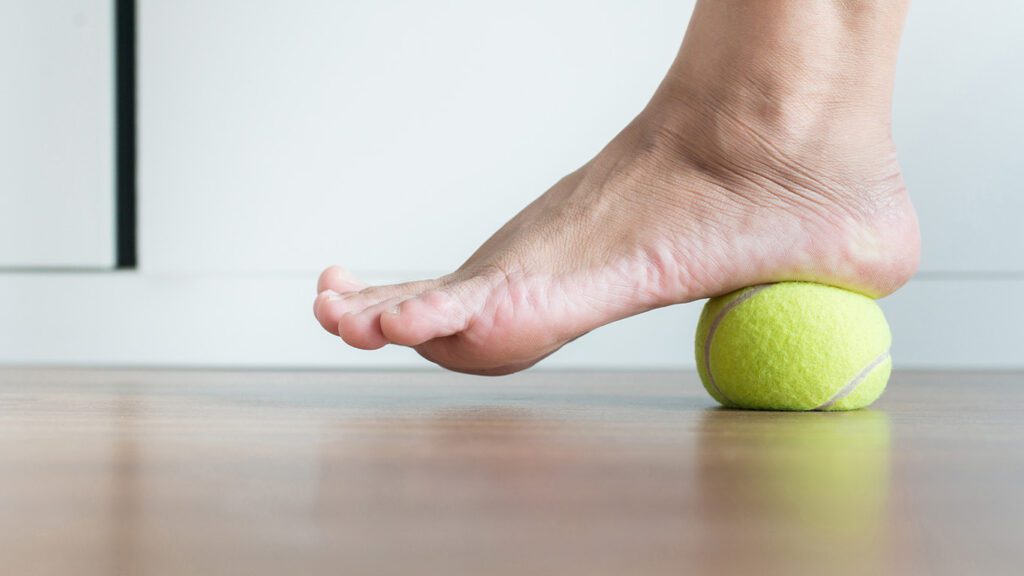Plantar fasciitis is one of the most commonly seen foot injuries in the world, and it strikes without warning. Occurring with a strain or tear of the plantar fascia—a thick tissue which attaches the heel bone to the base of the toes—the effect of this pesky injury ranges from mildly persistent to randomly intense pain in the heel and/or along the arch of the foot. While repairing plantar fasciitis rarely requires surgery, some level of physical therapy will be needed to remedy it. Let’s discuss the root cause of this injury further, and cover three of the best at-home physical therapy options to address the injury.
What causes plantar fasciitis?
When pressure is applied to the foot during weight-bearing activities like standing or walking, it leads to increased tension in the plantar fascia. Pushing off on the ball of the foot and toes during normal walking or running further amplifies this tension. Over time—or with sudden, excessive use—the plantar fascia may experience a reduction in its elasticity and resilience. This deterioration of the tissue can lead to irritation in daily life and can cause a limp.
For athletes, plantar fasciitis typically shows up with the introduction of a new running program. A sudden spike in the applied pressure to the foot leads to quicker wear and tear. If you’ve recently gotten into running, or have adjusted your exercise routine to include longer, more strenuous running, the likelihood of the injury will dramatically increase.
What does plantar fasciitis feel like?
The pain caused by plantar fasciitis can be fleeting or persistent, but it typically spikes in a predictable manner. When you crawl out of bed to take the first steps of the day, and immediately after applying intense pressure to the foot are the most common times for pain to spike. The feeling is sharp and typically localized at the heel or along the arch of the foot. If you’ve recently increased time spent on your feet and that occurs, it is safe to assume that you have gotten a case of plantar fasciitis.
How to treat plantar fasciitis
In all reality, the prospect of this injury is not very dramatic. However, if it is not addressed, the pain can linger and become a hindrance to your training. Here are three simple physical therapy tips that you can try at home to work through plantar fasciitis.
- Stretching exercises
Stretching exercises can help relieve tension and improve flexibility in the muscles and tissues surrounding the plantar fascia. Three common stretches for plantar fasciitis are:- Calf stretches: Stand facing a wall with one foot forward and the other foot back. Keep the back heel on the ground and lean forward, feeling the stretch in the calf of the back leg.
- Plantar fascia stretch: Sit down and cross one leg over the other. Using your hand, pull your toes back towards your shin until you feel a stretch in the arch of your foot.
- Heel raises: Stand facing a wall with your hands pressed against it for support. Slowly lift off of your heels and onto your toes. You should feel the stretch throughout the arch of your foot.
- Strengthening exercises
Strengthening the muscles and tendons in the foot can lead to vastly improved stability and support. Do the following exercises for sets of 10-15 with each foot. Imagine your foot muscle as any of your larger muscles, flexing it as you complete each rep.- Towel curls: Place a towel on the floor and use your toes to scrunch and pull the towel towards you.
- Marble pickup: Place marbles on the floor and use your toes to pick them up and place them in a cup.
- Massage
Assuming you haven’t completely torn the plantar fascia—you’ll likely know if you have—massaging the tissue along with stretches and strength exercises will help ease the pain. This can be quite painful itself, but will pay off in the long run. Simply rubbing along the arch of the foot to find the most tender spots and then focusing on those areas will help a great deal. You can also take massage a step further by placing a small ball on the floor and rolling the arch of your foot over it gently. Again, it will feel painful when you find the most tender spots, but treat it as if you are working out a knot and you will thank yourself after.
How long will it take to recover from plantar fasciitis?
Mild to average cases of plantar fasciitis that are addressed with proper physical therapy and rest will typically clear up in a week or two. This is not a debilitating injury, so you technically can continue to exercise while you treat it. Lighten up your regimen a bit and pay attention to your pain level to ensure you don’t further stress the tissue.
Again, this is one of the most common foot related injuries in the world, with more than two million cases reported per year. In short, if you are a runner, you are likely to get it at some point. When it does come around, simply follow the steps listed above and you’ll be back to your normal training in no time!

With our 100% money-back guarantee and vetted coaches, anyone can achieve their full athletic potential. CoachUp is the safest and easiest way to find a coach for personalized training. Find your perfect coach today and become the athlete you want to be!
How useful was this post?
Click on a star to rate it!
Average rating 4.5 / 5. Vote count: 2
No votes so far! Be the first to rate this post.




